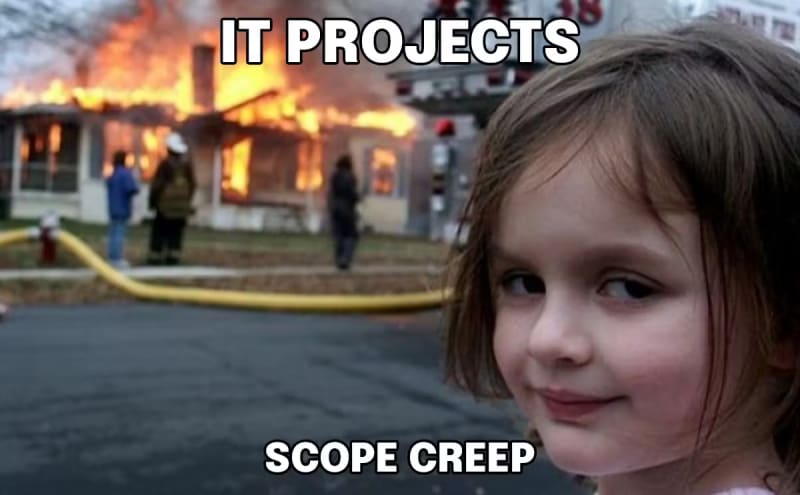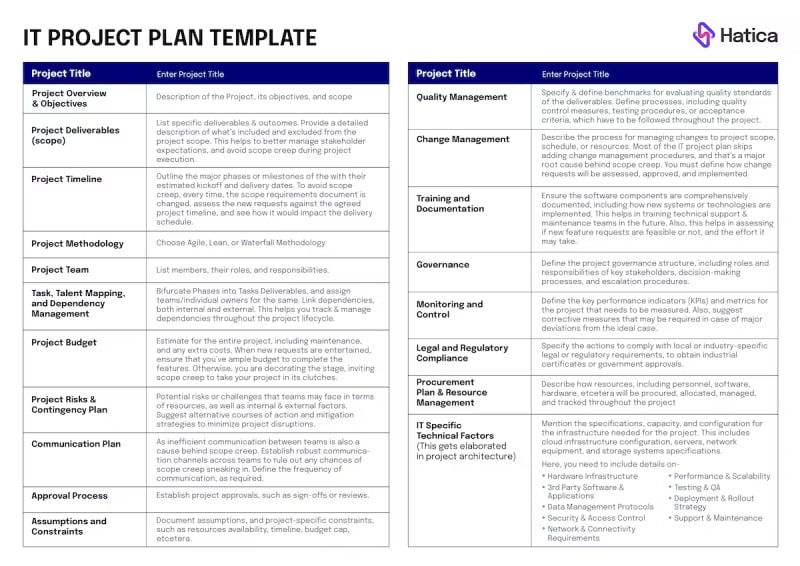For every IT project, lurking behind the shadows, lies a terrifying phenomenon known as scope creep. It preys upon unsuspecting teams and devours their resources, plans, and sanity.
Initially, scope creep is non-existent and harmless. And thus, IT professionals do not pay attention to it. They do not plan to tackle it proactively. But as the project progresses, scope creep reveals its insidious nature, dragging the project into a dark abyss of uncertainty.
Scope creep derails the project, and drains the SDLC team.
It won’t be an exaggeration to say that scope creep wreaks havoc on IT projects, and leaves a trail of shrinking budgets, stretched timelines, missed market opportunities, and plummeting team & developer productivity.
Read this insight to understand how you should devise an effective IT project plan to prevent scope creep.
What’s Scope Creep?
Over time, as the tides of customer expectations ebb and flow, the project must strive to expand its horizons, answering the ever-changing user needs & market demands.
Leaders understand the need to adapt and seize emerging opportunities. Because those who do not might soon be staring at an existential crisis.
Thus IT project stakeholders often have this insatiable thirst for altering components (software features) that are already hatched and are ready to be deployed to the production environment.
While a couple of modifications can be accommodated well, as the unanticipated changes accumulate, the IT project plan metamorphoses into a labyrinth of complications. Leaving the original IT project plan’s scope requirements a relic of the past.
If this itself wasn’t enough of a turmoil, you also have to juggle and balance the triumvirate of project quality, schedule time, and project cost.
This encroaching change in the scope of the project is what’s called ‘Scope Creep’.
How Stakeholders Sow the Seeds of Scope Creep?
In the realm of IT projects, scope creep emanates from multiple roots, sabotaging the best-laid plans and jeopardizing the project's fate.
Engineering managers, tech leads, or project managers, must identify & address the underlying factors to fortify the project against scope creep. The root causes of scope creep could be multiple, including—
- Absence of project scope
- Communication breakdowns within the project team
- Unclear objectives
- Unrealistic ambitions in terms of quality, resources, and timelines
- Too many decision makers (stakeholder overload)
- Ineffective change control processes
- Influence of last-minute customer feedback
For example, change of leadership at the top can radically change the nature and scope of projects at the bottom level. It is possible that the preceding leader was more inclined towards being at the frontier of innovation, while the new one is more inclined to set up processes to have a firm foot in the market.
And so, a lot of projects that were initiated under the last leader, may either get dropped or see significant changes in scope under the new one. This may trigger a domino effect on the dependent projects within the organization. Creating complete chaos.
Leadership shuffling is just one example. Probably, the least harmful. Here are some perilous causes (with example) of scope creep:
Absence of Project Scope
Assume that an org embarks on developing a mobile application to better serve their customers. Initially, the project objective is to create a basic mobile app with quintessential functionality.
However, due to inadequate requirements gathering, limited clarity on user expectations, and missing end-goal alignment, stakeholders inject new features and functionality requests throughout the development cycle.
Due to a lack of structure and direction, these new features are often not coherent. As a result, the project scope expands, timelines get extended, and resources are strained, ultimately leading to scope creep and potential budget overruns.
Unclear Objectives
Consider that a digital transformation leader aimed to integrate multiple existing software systems into a unified platform for improving efficiency. However, s/he didn’t clearly define goals and objectives for integration, data synchronization, and user workflows.
As the project progressed, stakeholders requested additional system integrations, custom data mappings, and complex workflow configurations, often without considering the time and effort required. This lack of clarity paves the way for scope creep to slip in and do what it does — derail the project from its purpose.
Gold Plating
Gold plating in IT projects is when teams voluntarily increase project specifications, without getting such plans approved by the top leadership. Consider it as a warm invitation to the scope creep. Gold plating scope creep consumes time and resources without much positive impact on CX.
Teams and individuals often engage in gold plating to win brownie points by impressing the leadership, enhancing user experience, or diverting defects. However, it can backfire.
It often causes unauthorized changes in scope requirements, which may even lead to project rejection/closure. Of course, Gold plating scope creep raises costs, risks, and stakeholder expectations too.
IT Project Plan Template to Prevent Scope Creep
Rope the beast, and safeguard your IT project from the creeping chaos. Else, your project may teeter.
Besides, you might not prefer to juggle with dev, testing, and production code on a festive Sunday evening, but rather indulge in a blissful revelry, with neon lights adorning the open rooftop nightclub.
And for that, you need an IT project plan template that’s equipped to keep you free from the freaky claws of scope creep. Keep in mind that project plans can vary depending on the specific requirements and nature of the project.
Here's a basic IT project plan template for agile teams, that you can use as a starting point. Feel free to customize it to fit your needs.
Safeguard Your Project from Scope Creep with Hatica
Scope creep is normal. Negligence can make it critical though.
To keep Scope Creep tamed, design your IT project plan to comprehensively define the project scope, make provisions to sieve incoming change requests, smartly manage stakeholder expectations, smoothly exercise change control, perform risk planning, and establish effective communication channels.
Make use of engineering analytics platforms (Say ‘Hi’ to Hatica) to keep track of key KPIs and metrics which can give you early signals to safeguard your project from seeping into the claws of scope creep.
For example, with Hatica, you can track metrics such as Cycle time, Variation metric, Velocity, etcetera to assess if your project might have been infiltrated by scope creep.
You may also look at unplanned work, and burndown charts, and analyze accumulated technical debt to get a clear picture of the situation.
Subscribe to our blog to ramp up your engineering processes & enhance developer productivity.





Top comments (0)